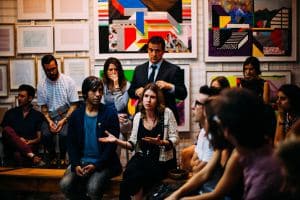The Bedouin community are a talented, resourceful, and significant part of the Negev population. Forecasts predict that the Bedouin population in the Negev is expected to reach one million residents by the state's 100th anniversary.
As part of our 2048 vision that aims to create autonomous and prospering centers of life in the Negev and Galilee, it is critical to examine and gain deep understanding of the situation of the Bedouin population in the Negev today, as well as the main challenges and issues it is facing.
As of the end of 2016, according to estimations, the Bedouin population in the Negev totals about 250 thousand residents (65 thousand in Rahat, 95 thousand in other recognized local authorities, about 18 thousand in regional councils and about 70 thousand in unrecognized settlements). The Bedouin population is young and growing twice as fast as the national average, with higher fertility rates compared to the overall population.
Analysis of the socio-economic condition of the Bedouin population in the Negev in recent years shows improvement in some aspects of life – education, employment, healthcare, and infrastructure. On the other hand, the Bedouin population is still the most impoverished and weak sector in the Israeli society, with ever-growing gaps between the populations.
CHALLENGES
 We mapped the main issues and challenges in the main aspects of life including reviews from the Central Bureau of Statistics and other analysis. We would like to mention that there are additional challenges, however the most central and significant of which are presented herein.
We mapped the main issues and challenges in the main aspects of life including reviews from the Central Bureau of Statistics and other analysis. We would like to mention that there are additional challenges, however the most central and significant of which are presented herein.
Education – Lack of kindergartens, scarce physical and financial resources allocated from the authorities, lack of informal extracurricular educational activities, and as a result of these, among other things, the availability of relevant positions to Bedouin students in the workforce is significantly lower.
Employment and Income – Language barriers, limited skills and training, low participation of women in the labor market, limited employment diversity, and being located in the geographical and social periphery, all result in low monthly pay.
Housing and Environment – The claim of land titles prevents the development of new communities, creates tension between the state and the residents, and also discourages Bedouin moving from unrecognized settlements for fear it might be interpreted as waiving the claim of land. In addition, about a third of the population lives in unrecognized settlements without basic infrastructures.
Healthcare – Poor living conditions, mainly in the unrecognized settlements, alongside familial marriage result in significantly higher morbidity rate compared with the overall population. There is also shortage of preventative care programs and a serious lack in infrastructure for disabled people.
Transport – Lack of public transport in the unrecognized settlements, deficient infrastructures in recognized authorities, as well as title claims for lands often hinder infrastructure development.
After recognizing the difficulties and gaps in Bedouin society and following government decision No. 3708 from 2011 (assisting populations with low employment participation rates), government decision No. 2397 was issued in February 2017, which constitutes the five-year plan for the Bedouin society throughout 2017-2021. According to the decision, 3 billion NIS will be invested in the Bedouin society in the Negev during these years. The decision is comprehensive and includes investment in empowering the local authority and improving public services (788 million NIS), investment in education (about 2 billion NIS), promotion of employment (340 million NIS) and development of public infrastructures (about 760 million NIS).

The main governmental organizations operating to promote the Bedouin population in the Negev are the Authority for Development and Settlement of the Bedouin in the Negev and the Department of Economic and Social Development for Bedouin Society in the Negev. There are also business ventures for integrating Bedouin employees in the labor market (Afek- The Bedouin Business Forum, Soda Stream, Siraj-Technologies, etc.), as well as numerous associations operating in the various areas of life.
HOW CAN WE HELP
Having analyzed the current situation and mapped the main issues, programs and organizations operating to promote various areas, and following the study conducted by the Brookdale Institute, here are the main issues left with insufficient solutions and that we think require immediate solution:
- Establishment of a long-term vision and planning for the entire Bedouin society by understanding the challenges, special needs and recognizing the current trends and forecast. In the current state of affairs where the Bedouin society suffers from wide gaps in the main areas of life, yet the cis growing fast and is expected to amount to one third of the Negev's population, it is necessary to create an infrastructure for high quality of life for the Bedouin society, which will allow a future with equal rights for all residents of the Negev.
- Social economic growth processes in the authorities, with emphasis on Rahat. Looking at the predictions for 2048, Rahat's population is expected to grow to about 300 thousand residents, making it the second largest city in the Beersheba district. Given the current trends, the city may become an inhibiting factor that would threaten the growth of the Negev as an autonomous center that provides high quality of life for its residents. The process of dedicated socio-economic growth planning could make the city prosper and become a regional center of attraction in terms of demography, employment, culture, education, etc.
- Investment in infrastructures and physical facilities with an emphasis on transportation in the communities and physical facilities for informal education (public spaces and buildings for informal activities).
- Handling local authorities' difficulties: the local authorities are dealing with challenges that include insufficient self-income, which leads to dependence on governmental budgets and unfamiliarity with governmental operations.
- Improvement of Hebrew knowledge among young Bedouins. The inability to converse in Hebrew is a main obstacle that makes it difficult to integrate into society, acquire higher education, and of course, enter the workforce.
- Creating unified leadership from authorities and organization leaders that will create mutual inspiration and collaboration to influence the district and regional decisions in light of the vision to be established for the Bedouin society in the Negev.
- Social integration to create Israeli identity in the Negev, which includes all sectors and populations by establishing social programs for multiple ages from various populations.


